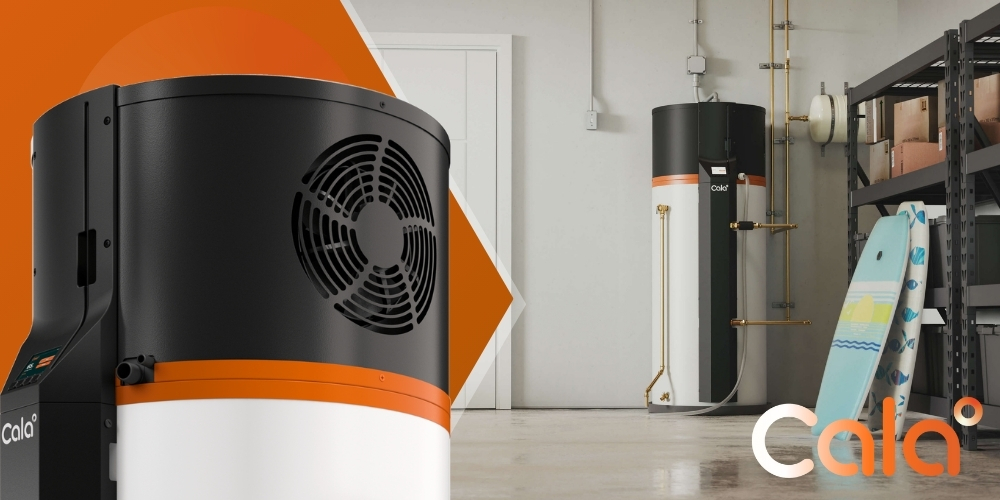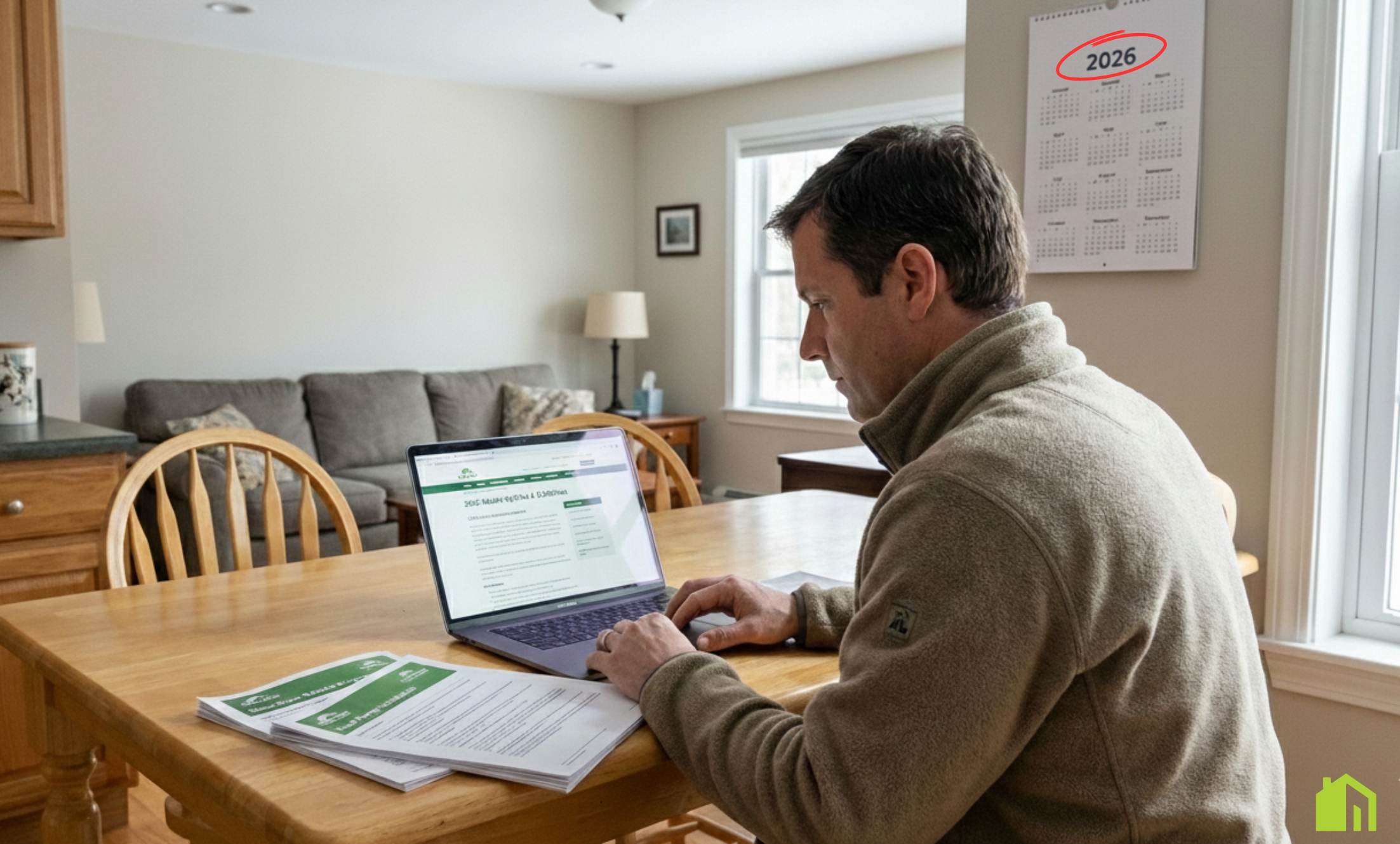What to Expect from a Commercial Rooftop HVAC Replacement Project

Intelligent Heat Pump Water Heaters for Massachusetts Residential Homes — Why SumZero Selects Cala
By SumZero Energy Systems — Massachusetts’ #1 Heat Pump Installation Team
Picking a new water heater once involved a simple decision between gas and standard old electric, praying the hot water wouldn't be gone when there were two showers in a row. That's no longer the case. Now, the ideal solution for the majority of Massachusetts homes is a smart heat pump water heater (HPWH). This isn't the typical hybrid of which you might have heard, but a rather new breed of unit that adapts to your home's schedule, accommodates your energy usage, and maintains comfort consistently while consuming a lot less energy.
When homeowners want to have it exactly right the first time, our team is discerning about what products we choose. We consider the landscape and inspect the details before determining that they might work with Cala, a company that produces a high-technology hot water heater that modern homes need: intelligent, consistent, and efficient hot water — installed properly. This article describes why this alliance matters, how the tech benefits your home, what you should expect from our installation, and the handy information (rebates, credits, fit questions) homeowners inquire about daily.
Why This Alliance Is Important
(and What It Does for You)
There are two parts to a successful hot water solution:
Great technology
A system that makes you comfortable and uses less energy.
Great installation
Design, placement, airflow, electrical, condensate handling, commissioning, and long-term support.
Cala provides a tailor-built, smart HPWH platform. SumZero provides actual-world experience so that it works perfectly in real Massachusetts homes.
Together, we provide three things homeowners report wanting:
Accurate hot water at peak periods without guessing.
Cheaper monthly energy bills without compromise on comfort.
It is a future-proof solution that addresses the trend towards greener, all-electric homes.
Simply put: We get hot water. We know how to properly install heat pump technology. This combination makes a water heater upgrade a smart, long-term decision.
The Homeowner's Dilemma That We Are
If you have had a gas or a typical electric water heater, then you know the problems:
Hot-cold swings on hectic morning routines.
Higher electricity bills than hoped for.
No real insight, no real control.
A replace cycle that is experienced as "buying the same thing again."
Typical hybrid: Heat pump water heaters perform better, yet they still react: They delay until the tank cools off, then warm it up again. Homeowners averred they desire a system which thinks ahead—a unit which is a breeze to operate, handles peak load graciously, and does not make them compromise.
They fill that gap, which is why we work with them.

Why a Smart HPWH is Different
A standard electric water heater makes heat by passing an electric element, a giant toaster coil, through the tank. A heat pump water heater does it another way: it takes heat from the air it lives in and puts it into the water. Because it costs less energy to move heat than create it, heat pump water heaters run on much less power than typical electric ones. And they avoid burning gas, venting, and pollution.
A smart HPWH goes one step further:
It adapts to your home's schedule (morning showers, nighttime laundry) and preheats when demand isn't yet high.
You can use the app to check, plan, or increase hot water whenever you want.
It has a compressor that can change speed to fit what you need (not just "on/off").
It is achievable with a mixing valve holding water at the proper warmth for improved efficiency and then providing a sustained, safe warmth for usage. This is also possible with the availability of additional warm water at peak usage times.
It goes nicely with a contemporary home — primed for solar, time-of-use, and information you can view at a glance.
Result: more stable comfort, less energy use, improved control.
Why a Smart HPWH is Different
From what is visible on-site, there are three things certain for homeowners regarding the points of Cala:
1) Ease That Is Effortless
Consistent hot water at peak use is the ultimate test. Through forecasting demand and using a mixing valve, Cala maintains a steady supply. That results in less "uh oh" when two showers coincidentally happen at once or someone turns on the dishwasher.
2) Controls That You'll Ever Use
App functionality is key when done properly. You can check if there's hot water, turn up the heat for guests, view energy usage history, or simply set it and leave. As installers, we appreciate performance data — it allows us to address little issues before large ones form.
3) Future-Ready from Day One
Massachusetts is going towards clean, electricity-based homes. Cala's strategy combines well: it is scalable for solar power and accounts for time-of-use rates when needed. If you foresee solar energy at some time, or already have it, this water heater won't stop your home from being efficient.
4) A Company That Stands Behind Its Product
Cala backs every unit with a 10-year parts warranty and 3-year labor warranty — a strong sign they stand behind both the technology and the people who install it. At SumZero, we respect that kind of commitment because it mirrors our own approach: taking care of homeowners and supporting our partners with the same level of trust and accountability.
What SumZero Offers As Your Installer
(Why It Matters)
Even the best system won't work so great if installed wrong. Our task is getting your new HPWH working perfectly inside your home, not on a drawing board. This is what our approach is:
Right-size design.
We measure how much water your home needs and discuss the high-flow fixtures, filling bathtubs, and washer usage.
Best installation and ventilation.
HPWHs require air to make the heat move. We consider the room size, doors, vents, and — when necessary — ducting solutions for high performance and low noise.
Clean handling of electricity and condensate.
Safe power, tidy routing, and a trustworthy drainage plan are essential.
Commissioning correctly.
We don't just "turn it on." We verify performance, position the mixing valve, help you with the app, and verify your comfort objectives.
Rebates, credits, and financial assistance.
Mass Save, federal 25C, and the 0% HEAT Loan (if applicable) — we'll help you with that.
We take special care.
Our teams respect your home, protect your floors, and leave the place nicer than they found it.
Aftercare you can count on. Questions years down the road? We're here. The whole concept of a smart system is long-term confidence, not a one-day installation.
Costs, Incentives, and Lifetime Value
Two parts matter here: upfront cost and operating cost.
→ It is a better unit than a standard electric or simple hybrid. Tax credits and rebates make a big difference. A lot of Massachusetts homeowners rely on the 0% HEAT Loan for easier payments.
→ Month after month, the intelligent HPWH's effectiveness is where the value lies. By transferring (not creating) heat and by scheduling heating intelligently, homeowners consistently experience significant decreases in water-heating energy consumption — particularly relative to resistance electric, and many times relative to gas or delivered fuels when full costs are factors.
If you'd like figures specific to your home (household number, showering usage, energy costs), we'll do the math at your consult and provide you with a clear estimate of payback, lifetime cost saving, and the rebates for which you qualify.
Are Smarter Heat Pump Water Heaters Good for Your Home?
It is feasible for many Massachusetts homes. We will cover:
→ Household size and routines. Families with up to about 5 people usually do well with the standard setup; we will give advice for larger families or special situations.
→ Space and ventilation. We check the space, door vents, or ducts if necessary, and ventilation so the system operates properly.
→ Location. Basements are typical, as are utility rooms. As the unit functions, it removes air that feels like a dehumidifier — a typical plus for basements.
→ Electrical. We check panel capacity and proper wiring; no installation day surprises.
→ Future plans. Now or in the future for solar? Time-of-use rates? We'll put the system on so it grows with your home.
[[cta-heatpump]]
Why Is Cala Different from "Traditional Hybrids"?
✪ Control and Convenience:
Cala integrates intelligent tech with a mixing valve to remain comfortable, even when it is busy. Most standard hybrid units have simple modes and react only when the tank becomes chilled.
✪ Care and Trust:
Performance insights help you recognize problems early on and keep you on your feet for surprises. Traditional deployments are mostly "wait and see."
✪ Timing and Efficiency:
Variable driving and improved scheduling assist in energy saving with the maintenance of comfort. Ordinary hybrids operate more often and at undesirable times.
✪ Future-Ready
The design of the Cala accommodates with solar power, intelligent homes, and plans for utilizing electricity. Most older hybrids were not built for that usage.

What to Expect with SumZero
(From the First Call Through the First Shower)
✪ Talk & Pictures
We'll first glance at your objectives and take some fast photos of the current installation: the water heating unit, panel, and surrounding room.
✪ Right-Fit Design
We fit your hot water consumption and available spaces to a design which we endorse.
✪ Chaplain: A Comprehensive
Your quote is going to be transparent, includes information for installation, accessories, and a checklist for incentives. The paperwork assistance takes care of our end.
✪ Professional Installation
Licensed, insured, and detail-orientated. We dispose of the old unit, prepare the site, install and commission a new system, and leave the site tidy.
✪ App Introduction and Instructions
You'll discover how to see hot water supply, schedule increases, and view consumption — without being "technical."
✪ Support and Help
We're your long-term partner. Got a question? You call us — that's what homeowners deserve from the #1 heat pump installation company.
Common Questions We Get
(And Easy Answers)
Smart heat pump water heaters move heat from the surrounding air into the water instead of generating heat directly. This makes them up to three to four times more efficient than standard electric models. Cala’s intelligent system takes it further — it learns your household’s patterns, preheats before busy periods, and gives you app-based control to monitor or boost hot water anytime.
Most hybrid water heaters react when the tank cools. Cala predicts when your home will need hot water and heats proactively, saving more energy while maintaining comfort. It also features a variable-speed compressor, integrated mixing valve, and performance monitoring portal, giving both homeowners and installers a smarter, more reliable experience.
Savings depend on your energy source and usage, but many Massachusetts homeowners cut their water-heating costs by 50–70% when switching to a heat pump system. Cala’s intelligent controls add even greater efficiency. Add Mass Save® rebates, federal 25C tax credits, and potential 0% HEAT Loan financing, and most families see real payback within just a few years.
Yes — most Massachusetts homes are a great fit. Cala’s 65-gallon design comfortably serves households up to five people and can prepare up to 90 gallons ahead of peak use. The system needs adequate space and airflow, similar to a dehumidifier, and our team at SumZero handles every detail — from placement and ducting to electrical and performance checks.
SumZero Energy Systems is Massachusetts’ #1 heat pump installation team, trusted for precision, transparency, and high-quality service. We manage every step — design, installation, rebate paperwork, app setup, and long-term maintenance — so homeowners enjoy smarter comfort and lasting confidence. With SumZero, you’re not just buying equipment; you’re gaining a partner who stands behind it.
Why We Feel Secure Recommending This to Massachusetts Homeowners
We have a simple promise: we only install solutions that we would use in our own homes. Cala’s approach — being smart, having control, and being ready for the future — matches what we have learned from many talks with homeowners in the state. Together with SumZero’s careful installation standards and ongoing support, this water-heating upgrade makes sense right away and will last well with your home. Cleaner heat. Smarter comfort. Fewer bills.
Ready to Take the Next Step?

To learn more about Cala’s technology and vision, visit Cala Systems.
Planning Your Commercial Rooftop HVAC Replacement
When it's time to replace your rooftop HVAC system in Massachusetts, understanding the scope and process of the project can save you time, money, and unnecessary stress. Whether your system is aging, underperforming, or pushing your utility bills higher each year, a rooftop unit replacement offers an opportunity to boost comfort, improve energy efficiency, and support long-term building performance.
Evaluating the Right Time for Replacement
Knowing when to replace a commercial rooftop unit can be just as important as the replacement itself.
- Systems nearing 15-20 years in age are typically past their prime
- Frequent repair needs and rising energy costs are clear warning signs
- Inconsistent indoor temperatures may reflect faulty performance
Many businesses in Massachusetts wait too long to replace rooftop HVAC units, missing out on thousands in potential annual savings due to inefficient systems.
If you're unsure whether your commercial unit needs replacement, an energy audit can highlight hidden inefficiencies that point to the need for an upgrade.
Choosing the Right Replacement Strategy
Not all commercial rooftop unit replacement strategies are created equal. Some businesses may benefit from a like-for-like replacement, while others should explore more advanced, high-efficiency options.
Important considerations include:
- Building size and layout
- Expected occupancy and cooling load
- Integration with existing ventilation or control systems
In some cases, it may be worthwhile to consider split systems or new energy-saving features like economizers or variable speed technology from trusted brands like Mitsubishi Electric or Daikin.
Budgeting for the Cost to Replace a Rooftop AC Unit
One of the top concerns for Massachusetts property owners is the cost to replace rooftop AC units. Keep in mind, costs vary widely based on system size, complexity, and existing infrastructure.
Here’s what contributes to those costs:
- Unit size and capacity (measured in tons)
- Labor and installation challenges (crane access, duct modifications)
- Permitting, inspections, and code compliance
- Energy efficiency ratings and optional enhancements
While the upfront cost might seem substantial, over time, a new energy-efficient rooftop system can reduce operating costs significantly—especially when combined with local incentives.
Taking Advantage of Local Incentives
Massachusetts businesses are in a great position to offset HVAC upgrade investments through rebates and support programs. For example, Mass Save® and other initiatives often offer rebates for qualifying commercial HVAC systems that reach or exceed certain efficiency standards.
It's worth reviewing programs supported by Mass Save® or the DOE, as they regularly update options based on annual budgets and energy targets.
The Process: What Happens During a Rooftop HVAC Replacement
Replacing a commercial rooftop HVAC unit involves more than removing an old system and dropping in a new one. From planning to final testing, the installation process demands coordination, safety, and precision—especially in busy part-commercial buildings across Massachusetts.
Step-by-Step Overview of the Project Timeline
A basic rooftop HVAC replacement will typically follow these steps:
- Equipment assessment and pre-installation planning
- Site prep and roof structural evaluation
- Removal and safe disposal of the old unit
- Crane lifting and new unit placement
- Electrical and ductwork connections
- Controls calibration and system start-up
- Final testing and building code inspection
Each phase can vary in duration depending on weather conditions, rooftop access, and how the new system integrates with the existing infrastructure.
A common oversight during replacement projects is underestimating the importance of proper system calibration—leading to years of suboptimal airflow and inconsistent building comfort.
Making Installation as Smooth as Possible
Here are a few ways Massachusetts building owners can help everything go smoothly:
- Schedule the replacement during off-peak building use, like holidays or weekends
- Coordinate access to the rooftop and mechanical room ahead of time
- Confirm your installation team handles debris removal and site clean-up
And remember: the quieter and safer the process, the better the experience for your tenants or occupants.
[[cta-heatpump]]
Maximizing Efficiency After a Rooftop AC Upgrade
Once your new commercial system is installed, the job isn't quite done. Making the most of your investment means focusing on post-installation efficiency and performance.
Scheduling Routine Maintenance and Checks
Regular maintenance is critical to keeping your new system running smoothly for years. That includes:
- Seasonal filter replacement
- Checking refrigerant levels and airflow
- Monitoring thermostat and control settings
- Inspecting electrical components for wear and tear
Building policies around scheduled assessments are one of the easiest ways to improve system reliability and energy savings in Massachusetts' variable climate.
Optimizing Your Building for Better HVAC Performance
Beyond maintenance, your building can also play a role in supporting HVAC efficiency. Here are a few recommended upgrades to consider after rooftop AC upgrade:
- Install insulation where heat transfer is highest
- Eliminate air leaks around windows, doors, and vents
- Upgrade to smart thermostats with zoning capabilities
The EPA estimates that improving the energy efficiency of HVAC systems in commercial buildings can cut annual energy bills by as much as 30%—a change that often starts with key post-upgrade adjustments.
Monitoring Data and Energy Usage
One of the true advantages of newer commercial HVAC systems is how easily they pair with smart monitoring tools. Using analytics software or integrated dashboards, you can:
- Track real-time energy use by zone or system component
- Set performance alerts to flag anomalies before they become repair issues
- Optimize runtimes based on peak usage patterns
And for energy-conscious businesses, this insight doesn’t just save money—it shows your commitment to sustainability and environmental responsibility.
Moving Forward with Confidence
Every building in Massachusetts has unique heating and cooling challenges. But when it's time for a commercial rooftop unit replacement, preparation and strategy make all the difference. From budgeting and choosing energy-smart equipment to planning the install and maximizing future efficiency, understanding the full process helps you lead upgrades with clarity.
A successful rooftop HVAC upgrade isn’t just a replacement—it’s a long-term investment in your building’s performance, tenant comfort, and energy resilience. By taking a proactive approach and exploring all the resources available to Massachusetts property owners, you're laying the foundation for a more sustainable and cost-efficient future.
Upgrade your commercial rooftop HVAC system to reduce energy costs, increase comfort, and unlock long-term savings. Learn how a rooftop unit replacement can transform your building’s efficiency.
Upgrade Rooftop HVACYou Might Also Like…
Continue learning with handpicked articles that inform and inspire.
Not Sure Where to Start? We’ll Guide You
Let our experts design the right heating and cooling solution—customized for your comfort, your layout, and your energy goals. No pressure. Just clarity.
Request FREE ESTIMATE









